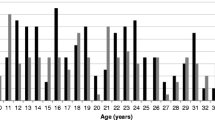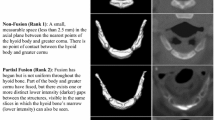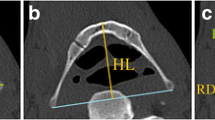Abstract
Purpose
Recognition of injury to the hyoid bone is intrinsic to post-mortem examination. Given its superficial location in the neck hyoid fractures are generally associated with some form of compressive neck force although they are well recognized in the peri-mortem period, in the context of manual handling and resuscitation. Hyoid fractures are variably reported to occur in manual strangulation and during hanging.
Methods
In this study Computer Tomography (CT) scans of the head and neck of 431 deceased persons (235 males and 196 females) between the ages of 1 day and 100 years of age (mean age 35.93 ± 24.15) and including 25 victims of hangings were examined to reveal the pattern of age-related change and the types of injury that occurred. Hyoid variants were also documented.
Results
The synchondroses between greater cornua and body were found to progressively fuse with age although in the current sample 20 % non-fusion was observed beyond 65 years of age. Sex differences were evident in adult hyoid bones and discriminant function analysis correctly confirmed sex in 74.7 % of cases.
Conclusions
The greatest age-related changes occurred from puberty to post-adolescence and a linear regression equation successfully assessed age into three general categories in 87.7 % of cases. Hyoid fractures were documented in 24 % of victims of hangings and while previous reports indicate these are more likely in older age, when synchondroses are fused, in this study the average age of victims with fracture was 27 ± 10 years. In the majority of cases the site of ligature was below the hyoid bone and in only one on the hyoid body.




Similar content being viewed by others
References
Gupta A, Kohli A, Aggarwal NK, Banerjee KK. Study of age of fusion of hyoid bone. Legal Med. 2008;10:253–6.
Shimizu Y, Kanetaka H, Kim YH, Okayama K, Kano M, Kikuchi M. Age-related morphological changes in the human hyoid bone. Cells Tissues Org. 2005;180:186–92.
Di Nunno N, Lombardo S, Castantinides F, Di Nunno C. Anomalies and alterations of the hyoid-larynx complex in forensic radiographic studies. Am J Forensic Med Path. 2004;25:14–9.
Ubelaker DH. Hyoid fracture and strangulation. J Forensic Sci. 1992;37(5):1216–22.
O’Halloran RL, Lundy JK. Age and ossification of the hyoid bone: forensic implications. J Forensic Sci. 1987;32(6):1655–9.
Soerdjbalie-Maikoe V, van Rijn RR. Embryology, normal anatomy, and imaging techniques of the hyoid and larynx with respect to forensic purposes: a review article. Forensic Sci Med Pathol. 2008;4:132–9.
D’Souza DH, Harish SS, Kiran J. Fusion in the hyoid bone: usefulness and implications. Med Sci Law. 2010;50(4):197–9.
Koebke J. Some observations on the development of the human hyoid bone. Anat Embryol. 1978;153:279–86.
Nikolic S, Micic J, Atanasijevic T, Djokic V, Djonic D. Analysis of neck injuries in hanging. Am J Forensic Med Pathol. 2003;24(2):179–82.
Khokhlov VD. Injuries to the hyoid bone and laryngeal cartilages: effectiveness of different methods of medico-legal investigation. Forensic Sci Int. 1997;88:173–83.
Lebreton-Chakour C, Godio-Raboutet Y, Torrents R, Chaumoitre K, Boval C, Bartoli C, Adalian P, Piercecchi-Marti MD, Thollon L. Manual strangulation: experimental approach to the genesis of hyoid bone fractures. Forensic Sci Int. 2013;228(1–3):47–51.
Pollanen MS. Subtle fatal manual neck compression. Med Sci Law. 2001;41(2):135–40.
Pollanen MS, Bulger B, Chiasson DA. The location of hyoid fractures in strangulation revealed by xeroradiography. J Forensic Sci. 1995;40(2):303–5.
Pollanen MS, Chiasson DA. Fracture of the hyoid bone in strangulation: comparison of fractured and unfractured hyoids from victims of strangulation. J Forensic Sci. 1996;41(1):110–3.
Pollanen MS, Ubelaker DH. Forensic significance of the polymorphism of hyoid bone shape. J Forensic Sci. 1997;42(5):890–2.
Kim D, Lee U, Park D, Kim Y, Han K, Kim K, Han S. Morphometrics of the hyoid bone for human sex determination from digital photographs. J Forensic Sci. 2006;51(5):979–84.
Miller KWP, Walker PL, O’Halloran RL. Age and sex-related variation in hyoid bone morphology. J Forensic Sci. 1998;43(6):1138–43.
Parsons FG. The topography and morphology of the human hyoid bone. J Anat Physiol. 1909;43(4):279–90.
Papadopoulos N, Lykaki-Anastopoulou G, Alvanidou EL. The shape and size of the human hyoid bone and a proposal for an alternative classification. J Anat. 1989;163:249–60.
Balseven-Odabasi A, Yalcinozan E, Keten A, Akcan R, Turner AR, Onan A, Canturk N, Odabasi O, Hakan Dinc A. Age and sex estimation by metric measurements and fusion of hyoid bone in a Turkish population. J Forensic Leg Med. 2013;20(5):496–501.
Standring S, editor. Gray’s anatomy: the anatomical basis of clinical practice. 40th ed. Edinburgh: Churchill Livingstone; 2008.
Larsen WJ. Development of the head, the neck, and the eyes and ears. In: Human embryology. 1st ed. New York: Churchill Livingstone; 1993.
Sprinzl GM, Eckel HE, Sittel C, Pototschnig C, Koebke J. Morphometric measurements of the cartilaginous larynx: an anatomic correlate of laryngeal surgery. Head Neck. 1999;21:743–50.
Garvin HM. Ossification of laryngeal structures as indicators of age. J Forensic Sci. 2008;53(5):1023–7.
Green H, James RA, Gilbert JD, Byard RW. Fractures of the hyoid bone and laryngeal cartilages in suicidal hangings. J Clin Forensic Med. 2000;7:123–6.
Luke JL. Asphyxial deaths by hanging in New York city: 1964–1965. J Forensic Sci. 1968;13:359–69.
Simonsen J. Patho-anatomic findings in neck structures in asphyxiation due to hanging: a survey of 80 cases. Forensic Sci Int. 1988;38:83–91.
Mukhopadhyay PP. Predictors of hyoid fracture in hanging: discriminant function analysis of morphometric variables. Legal Med. 2010;12(3):113–6.
Naimo P, O’Donnell C, Bassed R, Briggs CA. The use of computed tomography in determining developmental changes, anomalies and trauma of the thyroid cartilage. Forensic Sci Med Pathol. 2013;9:377–85.
Author information
Authors and Affiliations
Corresponding author
Rights and permissions
About this article
Cite this article
Naimo, P., O’Donnell, C., Bassed, R. et al. The use of computed tomography in determining development, anomalies, and trauma of the hyoid bone. Forensic Sci Med Pathol 11, 177–185 (2015). https://doi.org/10.1007/s12024-015-9655-y
Accepted:
Published:
Issue Date:
DOI: https://doi.org/10.1007/s12024-015-9655-y




